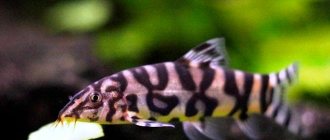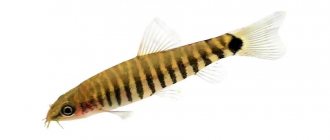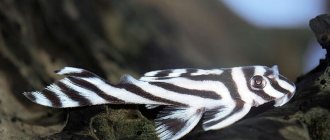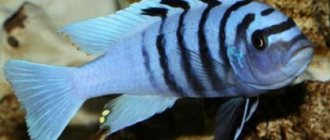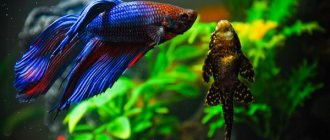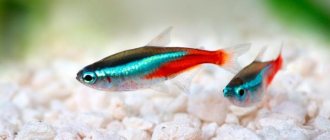Botia occupies an honorable place in the list of fish loved by aquarists. This fish has character, gets used to its owner and recognizes him, and is distinguished by extraordinary habits. At the same time, the botia remains a fairly well-mannered inhabitant of the aquarium: it does not dig up plants and does not disturb the general appearance of the biotope. Aquarists can keep it even with little experience; they just need to follow the rules of maintenance and care.
Description
General external characteristics for different types of battles are:
- Fusiform body
- Two pairs of short antennae near the mouth
- The fins are medium-sized, without growths, spines and veils
- Spikes are present under the eyes, they become noticeable in situations when the fish is defending itself from predators or feels danger.
- The pectoral fins are located just below the gills, which makes the fish similar to catfish.
- The mouth is located below, which helps the fish to slowly collect food from the bottom
- A light or golden edging gives expressiveness to black eyes.
Notes
A closely related species is Botia dario.
Don’t forget that loaches have a sharp, movable subocular spine, which is usually hidden in the subcutaneous pouch, but when frightened it appears. Therefore, when catching, it is necessary to handle carefully, as they can get entangled in the mesh of the net, and the spike of large individuals can injure a person’s skin.
Botsia, like many loaches, is susceptible to a disease called “wasting” and is characterized by weight loss. It is particularly common in recently imported specimens and is thought to be caused by flagellates of the genus Spironucleus. This can be treated using the antibiotic Levamisole or Panacur, a medicine for animals.
Types of battles
These aquarium fish come in a variety of colors and adult sizes.
- Botia clown (Botia macracantha) - has a golden-orange body color, with large transverse stripes-spots of dark gray color. There are usually 2-3 of these spots. It grows in captivity up to 20 cm. The most popular type of botia in aquariums. The name clown fish is due to the similarity in color with the sea clown fish (the difference is that the spots on that fish are not dark, but white).
- Botia marbled is small in size (up to 7-9 cm), the body has a milky yellow color with black, irregularly shaped, small spots from head to tail. The fish has a body structure characteristic of bots. Lives up to 7-9 years.
- Botia modesta (blue) - has a two-color body: the entire body is silver-blue, and all fins, including the tail, are red. Size - up to 20 cm. Loves interesting bottom design - driftwood, stones, plants.
- Botia striata (Botia zebra) - on a sandy background there are many narrow diagonal stripes running from the back to the tummy. The body shape is similar to a clown, but is much smaller - it grows no more than 7 cm.
- Tiger loach - has narrow transverse stripes, dark on a light background. Stripes can be either contrasting or invisible. There are small spots in the gill area. Dimensions no more than 17 cm.
- The dwarf botia is a red-listed species in nature. Dimensions – up to 6 cm, the smallest of the bots. Color – silver-gray round spots in two rows on a black background.
- Royal botia has a light orange body, narrow dark gray stripes across from head to tail, an elongated muzzle and dark gray spots in the gill area.
- Botia lecomte is an oblong body up to 15 cm long, has a greenish-gray color with a golden back. The muzzle is gray. Quite a calm species, reproduces well in a home aquarium.
- Botia histrionica - has a light sandy body, on which there are transverse stripes in the form of crosses. The size in the aquarium is up to 13 cm.
- Botia morleti - has a small size (up to 10 cm), a grayish-silver body with a dark spot near the tail and a reddish tint on the fins. Because of its gray color it is called “mouse botia”. Pectoral and dorsal fins with a reddish tint. Can grow up to 20 cm.
- Botia dario - the body shape is similar to the clown botia, the main color is bright yellow, along it there are black stripes across the fish from head to tail. They are located somewhat diagonally. The fish is very active and has a rather grumpy character. Packy.
- Botia kubotai (checkerboard) is a small fish (up to 10 cm), light orange in color, with wide blue-black irregular stripes running across its entire body. The tail is transparent, with black stripes.
- Botia almora - the transverse stripes on the body of the fish resemble a net, they form a bizarre pattern. These bots are one of the smallest; in an aquarium they do not grow more than 7-8 cm.
Habitat
Asia: India, Pakistan, Bangladesh.
Endemic to the Western Ghats and Maharashtra in India.
It was first discovered in the Tunga River, which flows through the Indian southern state of Karnataka, and is a tributary of the Tungabhadra River, which itself is a tributary of Krishna.
The latter flows east from the western state of Maharashtra through Karnataka and Andhra Pradesh before emptying into the Bay of Bengal. Later it turned out that they live in two more rivers of India - Panchganga and Koyna, as well as in some reservoirs of Pakistan and Bangladesh.
They prefer mountain rivers and streams with clean water, choosing areas with a pile of boulders, stones, a layer of fallen leaves and a sandy bottom, the maximum depth was about 1.5 m, there was forest cover.
According to the IUCN, it is currently critically endangered in the wild due to habitat change combined with a small natural range.
Maintenance and care
Habitat in nature - Indonesia. Later, loachfish began to be bred on farms in Southeast Asia, so modern fish bred in captivity are somewhat less demanding in terms of living conditions. The main condition is that the fish must be kept in a school. For some varieties (clown botia) the minimum is three fish, for others – no less than 6. On average, when planning an aquarium setup for a clown botia, you need to count on 5-6 or more fish.
- The volume of the aquarium depends on the size and number of fish. For a flock of clowns, you need an aquarium of at least 250 liters, because they grow 15-20 cm. For smaller species (for example, dwarf loaches), 150 liters per flock will be enough. Aquariums smaller than 150 liters are not suitable for keeping bots.
- Temperature 24-27°C. Depends on the species: some can tolerate colder temperatures (from 22°C), others need warmer water (up to 29°C)
- Hardness 6-20°. Different species like different waters. Thus, for the most common type - clown bots - a soft one (6-12°) is preferable.
- Acidity 6.5-7.5. The average value is indicated; for different types of botia it may deviate slightly.
- Botia appreciates clean water with good flow and good aeration. A filter, compressor and weekly water changes are required.
- At the bottom you can arrange a varied landscape: piles of stones, plants with wide leaves, grottoes, castles, pipes, etc. Bots love to explore the bottom, and if they are bored, they can become depressed. The best way to avoid this is to have an interesting aquarium design. Some individuals like to feast on live plants. In this case, there is only one way out: replace living vegetation with artificial ones.
- There must be space for swimming. The fish love to rest on leaves or on the ground, but they also don’t mind swimming around the entire aquarium. Most bots are active in the dark or in the evening, when the light is dim.
Interesting Facts
A few of them:
- Botsia are bright fish. But their color becomes discolored under stress or fear, or from old age. Then the fish practically merges in color with the bottom filler and becomes invisible. When excited, on the contrary, all shades of color are very bright.
- If the fish does not have time to hide in case of danger, then it pretends to be dead.
- She also sleeps - belly up, on her side or head down. An inexperienced aquarist usually gets scared, thinking that the pet has died.
- Before it rains, a flock of Botsy begins to worry. That is, they are a kind of barometer.
- Botia serve as cleaners of artificial home ponds from overly proliferating snails - for them it is a delicacy.
- Almost all fish species can interbreed, producing interesting new offspring. But only in natural conditions or with the help of hormones.
- In Asia, collecting the floating caviar of Botius is a good source of income. It is sold to fish farms. But natural fish populations suffer incredibly from this “business.”
Feeding
Food for these fish should be varied: both animal and plant. Since loaches are still predators, it will be very useful for them to add live food, in particular, bloodworms, to their diet.
In addition to protein foods, plant components are also needed, which are contained in specialized dry mixtures. Bots do not mind feasting on catfish tablets - long-lasting food that settles to the bottom, softens, and can be chewed. The oral apparatus of all bots allows them to do this successfully. There are also special foods available for sale intended for bots. They are balanced to maintain color and keep the fish healthy.
Dry food can sometimes be supplemented with vegetables and fruits: slices of cucumber, zucchini or melon.
Diversity of feeding is the key to longevity. How long do bots live in captivity? With the right diet and good conditions - up to 20 years.
History of appearance/discovery
Since ancient times, large representatives of the family have been the object of fishing among the local population.
One of the first species of botia discovered was Botia macracantha. The description of the species was made at the end of the 19th century (1852) by the famous Dutch ichthyologist Pieter Blecker. The fish received its specific epithet – “maracanth” (clown) for its bright and unusual coloring and very cheerful disposition. Later, the species was brought to Europe, where aquarists really liked it.
Botia Morleta has been known to aquarium enthusiasts since 1855.
A few years later, in 1865, Botia modesta was discovered, a very popular species in our time.
The year 1920 was marked by the discovery of a couple more species of now popular aquarium fish: the marbled botia and the striped botia striata, also known as the zebra botia.
Botia zebra
It is worth noting that scientists regularly find new types of bots. For example, quite recently, in 2004, a chess fighting game was described.
Chess botia
At the same time, the Swedish ichthyologist Morris Kotelata proposed to distinguish the clown loach into a separate genus - Chromobotia.
Thus, now science is only accumulating knowledge about bots and, perhaps, in the future we will see changes in the taxonomy of this group. It is possible that new colorful species of these wonderful fish will become available to aquarists.
Reproduction
Breeding bots at home is an almost impossible task. On fish farms, successful spawning is carried out using gonadotropic agents. This is not possible in a regular aquarium.
How to determine sex - in most cases, this will not be possible; females are practically no different from males. Experts say females have a rounder abdomen, and that's where the sex differences end. To breed in captivity, you need three males and one female, a strong current and a separate spawning aquarium.
Since reproduction of bots is almost impossible, fish from a pet store can be either farm-bred or captive-caught fry, grown to the age of 3-4 months.
Reviews
I bought three clowns a month ago. They don’t bother their neighbors, they chew on plants, and they have to supplement them with plant food. I feed him dry and frozen food, but for some reason they poisoned him with live food. Yuri
Gave me 4 fish for my birthday. It's interesting to watch them. They “talk” to us by clicking and clattering. They can sleep climbing on top of each other. When they get hungry, they start throwing stones at the glass. I tried to change the interior, the clowns didn’t like it, so they remade it in their own way. You won’t get bored with them. Svetlana, 47 years old, Stavropol
I bought a flock of 5 clowns for the occasion, I liked the colors. One got sick after a while, even the fins were noticeable, they became smaller. I treated him with antibacterial drugs, it seemed to help, the size of his fins was restored, but he still lags behind others in growth. The fish are trouble-free. They are very active, they play violently, after which scars remain, but heal quickly. Igor Borisovich
Compatibility with other fish
Since botsia is a schooling fish, problems with interspecific aggression usually do not arise. A school of fish is practically safe for any neighbors (except, perhaps, the dario botia). Here it is important to choose your neighbors so that they themselves feel comfortable next to these striped giants.
If the fish is left alone, and also quite old (over 6-7 years old), then it can show aggression towards its neighbors, especially new ones: building them, hunting for tails and fins, chasing them around the aquarium.
Considering that the botia itself is not averse to walking around the entire tank, it should have few neighbors: this way no one will disturb anyone. Overcrowding should be avoided. Otherwise, almost any non-aggressive and moderately aggressive fish that are comparable in size and do not have lush fins (golden ones) or growths (angelfish) will be suitable as neighbors. It is advisable to keep everyone in the same aquarium from an early age: it is more difficult for bots to accept beginners.
Aquarium
You will need a container of 100 liters.
If there is not enough space, the fish show aggression both towards members of their own species and other inhabitants of the aquarium.
A natural-style design may include a substrate of sand or fine gravel with lots of smooth, water-rounded stones, as well as driftwood, roots and branches.
Lighting may be relatively low and not all plants can grow in such conditions, such as Cryptocorynes, various Anubias, Ferns and Java moss. The latter have the added advantage that they can be attached to decorative elements in such a way as to provide suitable shading.
Plenty of cover should be provided. Objects with sharp edges should not be used for decoration. A tight-fitting lid is also necessary since these bots jump from time to time.
Water parameters:
Temperature: 21 - 27° C pH: 6.0 - 7.5 Hardness: 5 - 12° dH
They are intolerant of the accumulation of organic waste - it is necessary to control the content of nitrites in the water, to which these fish are very sensitive. They need active aeration, good filtration, and weekly changes of a third of the water.
Should not be added to biologically immature aquariums and adapts most easily to stable, biologically mature aquariums.
Features of behavior
As for behavioral characteristics, aquarists vocally report the main thing: the botia likes to lie down to rest in unexpected places and in unexpected positions. This fish can hide in a corner, turn over on its back with its head down, and lie like this for a long time. Even experienced aquarists who have long been familiar with this feature of the botia can get scared: has the fish died?
Diseases
In general, adult botia has good stable immunity. Infection with ichthyophthyriasis (semolina) and other fungal infections is possible. It is treated with the usual methods: increasing the water temperature, turning off the lights, adding special antifungal drugs. However, often, even if the entire aquarium is sick, the bots may remain unaffected by the infection. When treating an aquarium for infection, you should not remove healthy fish, so they can undergo preventive procedures.
